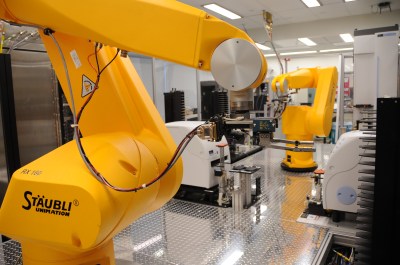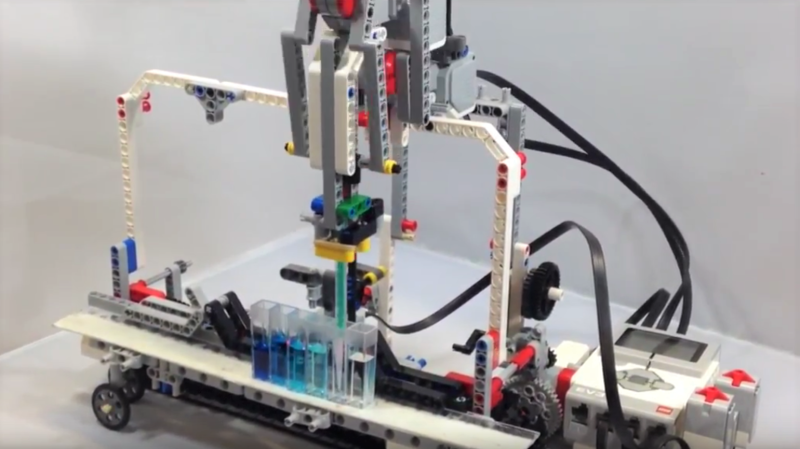A career as a lab biologist can take many forms, but the general public seems to see it as a lone, lab-coated researcher sitting at a bench, setting up a series of in vitro experiments by hand in small tubes or streaking out a little yeast on an agar plate. That’s not inaccurate at all – all of us lab rats have done time with a manual pipettor while trying to keep track of which tube in the ice bucket gets which solution. It’s tedious stuff.
But because biology experiments generally scale well, and because more data often leads to better conclusions, life science processes can quickly grow beyond what can be handled manually. I’ve seen this time and again in my 25 years in science, from my crude grad school attempts to miniaturize my assays and automate data collection to the multi-million dollar robotic systems I built in my career in the pharmaceutical industry. Biology can get pretty big in a hurry.

That’s a shame, because I feel like the life sciences lose a lot of promising young talent to other fields that have more initial pizzazz. STEM has become somewhat synonymous with robotics, and for good reason — robots are fun, kids love them, and they’re pretty cheap to build and getting cheaper and more capable by the day. It’s been hard to impress on kids that they can do big things in biology and chemistry simply because it’s so expensive to show them.
That’s why I was really jazzed when I saw these low-cost lab automation instruments built with LEGO Mindstorms. For the price of one $400 Mindstorms kit, [Ingmar Riedel-Kruse] and his colleagues at Stanford have built a couple of different liquid handling instruments with real potential. Not only are these instruments — a pipettor that can work in a one-dimensional space and a 2D gantry robot — great for STEM demonstrations, they’re also more than capable of doing real science.
Parts needed aside from the stock Mindstorms kit are minimal, comprised mostly of labware like cuvettes and microtiter plates. The business end of the pipettor requires a 5-ml syringe to be modified to work with the LEGO parts, but that’s not a complicated affair by any means. The video below shows a certain over-compliance in the mechanism which might result in positional inaccuracy, but given some of the LEGO builds we’ve seen here before, I bet that could be remedied. Overall I’m very impressed; honestly, I’ve seen instruments that cost hundreds of times what [Ridel-Kruse] spent that have half the capability and all of the slop.
We’ve covered a lot of home-brew instruments for the DIY life science lab, from Arduino-fied syringe pumps to 3D-printed centrifuges. Those are great tools, but they’re probably not going to engage a FIRST kid. Watching a liquid handler work, though, and understanding that there are bigger and better versions in modern biology and chemistry labs, might just spur a few kids to pursue careers in the “S” disciplines of STEM.
















Nice! I coach a FIRST Lego League team, definitely need to show them this the next time we meet. I bet they’ll get a kick out of seeing the robotics kit they’ve been using all year, being used for real science.
Nice build, but it’s not very low cost; Mindstorms kits are quite expensive when compared to DIY. Some cheap fake Legos from Aliexpress, a set of hobby servos and any microcontroller can do the same job for less money (but more challenges, like attaching servos to Legos and programming the microcontroller). Custom 3D printed parts would be a better choice than Legos, but not everyone has access to a 3D printer and CAD skills.
The pixelized photos look like photos of crime victims. It is a strange world now. I hoe I will never see pixelized photos of my kids.
“Being able to do hundreds of experiments at the click of a mouse is remarkably powerful, but the expense of the equipment involved has kept this technology squarely in the domain of deep-pocketed institutions.”
I imagine a similar technique would apply to material science?
The software side (how you program your dispensing operations) is just as important as the hardware.
Here, a flow diagram type language based on scratch would work really well. A lot of (all?) companies use this paradigm but Beckman Coulter do it extremely well. They have flow diagram building blocks with complete operations (transfer A->B / move plate / discard tips etc) to program their Biomek, as well as loops and variables and even additional “low level” programming of the robot, which can be done in visual basic for added flexibility.
Here’s an example of what the software looks like: http://www.igs.umaryland.edu/labs/grc/files/2014/10/PB_Biomek_Deck.jpg
For code presentation, functions can be hidden under their heading (code folding?) like I remember GFA BASIC and other IDEs can do. All in all, a very well thought bit of software worth looking at for inspiration.
No commercial interest in the product, just something I like to play with occasionally ;-)
Here’s the journal article: Gerber, L. C. et al. Liquid-handling Lego robots and experiments for STEM education and research.
PLoS biology 15, e2001413 (2017). https://journals.plos.org/plosbiology/article?id=10.1371/journal.pbio.2001413
A follow-up to this work was done in: Saar, L.; Liang, H.; Wang, A.; McDannald, A.; Rodriguez, E.; Takeuchi, I.; Kusne, A. G. A Low-Cost Robot Science Kit for Education with Symbolic Regression for Hypothesis Discovery and Validation. arXiv June 13, 2022. https://doi.org/10.48550/arXiv.2204.04187.
Probably worth mentioning Opentrons here, too (starts at ~5000 USD) https://opentrons.com/
On a similar note, I’m working on a “Hello, World!” for autonomous discovery in the physical sciences https://hackaday.io/project/186289-autonomous-research-laboratories. Open to thoughts!